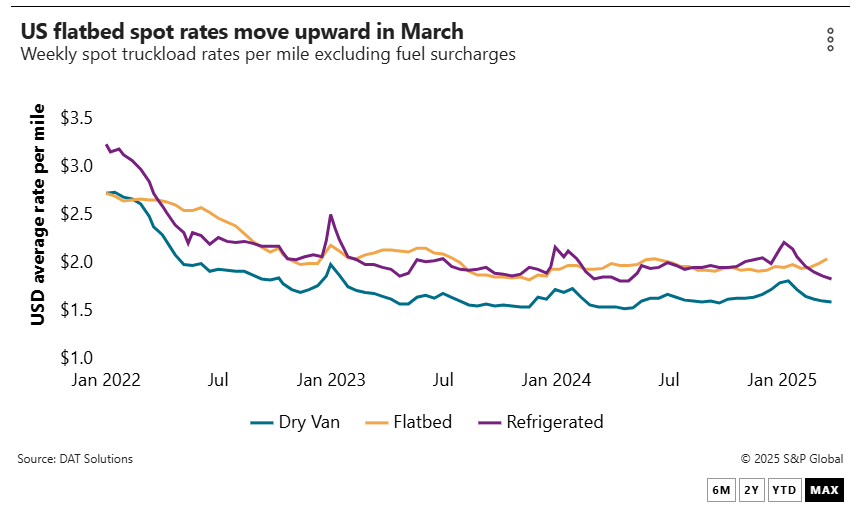
With tariff deadlines looming, importers are rushing to get industrial goods into the US, sending spot market demand for flatbed trucks soaring in recent weeks.
That indicates importers are struggling to find the capacity to move transactional loads of goods such as machinery, steel coils and beams and agricultural equipment ahead of tariffs on Canada and Mexico, while also trying to beat new levies on steel and aluminum as well as cars and trucks from all sources.
Add to that list reciprocal tariffs on a broad range of global imports that are scheduled to take effect April 2. Tariffs on Mexico and Canada are slated to be expanded April 2 as well.
“No one is able to quantify how this is going to impact things, but if your business makes things with aluminum or steel or lumber, you're buying now,”said Michael Regan, shipper consultant and chief customer relationship officer with logistics management firm TranzAct Technologies.

Flatbed spot rates rose 8.3% from late February through March 25 to $2.36 per mile on the 50 largest US truckload lanes, according to DAT Freight & Analytics.
Excluding fuel surcharges, flatbed spot rates on Truckstop's load boards are up about 7.5% year over year, according to research firm and Truckstop partner FTR Transportation Intelligence.
Year over year, posted flatbed spot loads moved are up by double-digit percentages — 34% last week, according to FTR, and 42% on DAT's load boards.
That doesn't indicate an inflection is coming in overall truckload demand or pricing, however. There is even a split between the spot and contract flatbed markets.
Instead, the sudden increase in transactional flatbed demand and rates appears more a market distortion caused by normal seasonality combined with pre-tariff demand.
“It really feels like it's not domestic production-driven but is import activity,” said Avery Vise, vice president of trucking at FTR.
Vise points out that spot market flatbed activity is strong in much of the US, especially the Southeast, but also in the Northeast and Midwest, areas with strong port gateways.
“We're seeing increases in the West as well, but much more recently than in the East,”he said. Capital goods imported from Asia would typically arrive in the ports of Los Angeles and Long Beach and move inland by rail, rather than flatbed truck, he said.
“It would make sense to see a much stronger increase [in flatbed spot demand] in the East than in the West”if import volumes of heavy goods were rising, said Vise.
Accelerated demand
The speed and timing of the recent increase in flatbed spot activity also points to a pre-tariff pull-forward of goods, said Dean Croke, principal analyst at DAT.
“We typically see flatbed demand and pricing move up over a longer trajectory headed toward May,”said Croke.“This year we've seen pricing move up quickly in March.”
Neither the US housing market nor the manufacturing sector have seen the type of surge that would account for the spike in flatbed demand, Croke and Vise both told the Journal of Commerce.
Shrinking flatbed spot market capacity is one factor in the spike, Croke said.“The overall attrition of carriers is having an effect on the specialized part of the market,”he said.
Contract flatbed rates have remained stable over the past three months, rising only 2 cents to $2.57 per mile, excluding fuel surcharges, in March, according to DAT.
“Large contract [flatbed] carriers are still decreasing rates to hold volume,”Croke said.
The DAT flatbed replacement contract rate index is down 6.2% year over year.“The market for moving things like roofing shingles is oversupplied,”he said.
It's also likely that those large contract carriers are shifting more assets to the spot market.
The flatbed volume spike will likely diminish after US tariffs take effect — if it is largely due to those tariffs.“There's a lot of reason to think this is the case, but we'll only know after the fact,”said Vise.

